DEGREES OF COMPARISON OF ADJECTIVES In English, as in Russian, ...

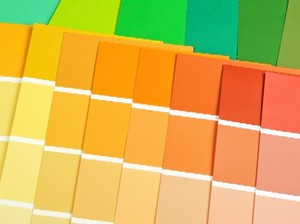
Probably everyone wants to achieve some bright and saturated colors of paints, and sometimes it is necessary to give a certain shade of paintwork. For such purposes, and used color for paint. Today I will tell you how to do tinting with your own hands and at home. Indeed, often we need to achieve a color that you simply cannot buy in a store, since it consists of several tones. The most interesting thing is that color can be used not only for diluting paint, but also as a ready-made mixture for painting small surfaces. And today we will consider all aspects of this material.
Colors for paint

I must say that now it is very easy to choose the right color for your type of paint. Manufacturers present a wide range of pigmenting compounds that can be used independently. By the way, color can be added not only to paintwork materials, but also to plaster or putty, thereby giving it the necessary colors.
Important! When choosing the necessary pigment in the store, consider what kind of lighting will be in the room. The fact is that painted surfaces can have a different shade. Artificial lighting will make cold colors muted and dark, but warm colors will brighten.
Table of mixing proportions of paintwork materials and color:
When mixing color and paintwork materials, do not overdo it. While this can produce richer colors, it can simply reduce the quality and properties of the ink.
If we talk about GOST, then the color scheme is:

In order to understand which colors are suitable for certain types of paint, I decided to make a small but understandable table:
Important! It is water-based paint that is the most popular for use in private houses and apartments. That is why one of the most popular can be safely called the color for paints on water based.
Consider some factors if you want to get the colors of water-based paints you need:
Important! Although mixing paint with color is not difficult, you can use this service at a hardware store. The point is that many specialty stores have special automated machines that allow you to mix the paint to the shade you need. In this case, you do not have to worry about the resulting color.
The price of such a composition is slightly higher than do-it-yourself paint - this should be taken into account when predicting your expenses for color and paintwork.
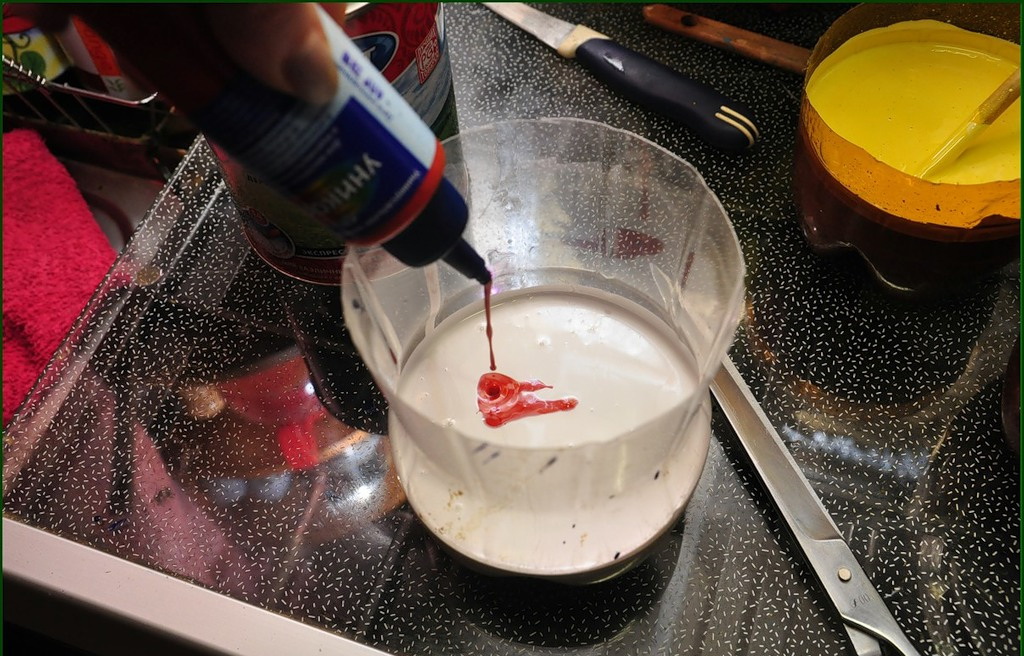
Adding red color
The mixing technology is very simple and does not require any special skills. A beginner who does not have any experience in painting surfaces will quite cope with this task. Do-it-yourself paint tinting is done when there is a desire to paint a room in several different colors. Do not forget that the colors must be compatible with each other.
The sadness of such a process is that you won’t be able to mix the same shade twice in a row, so immediately calculate how much mixture you need for coloring. The process sequence is very simple, we take the color, add it to white paintwork materials and mix. However, keep a few things in mind:
By the way, if you have some amount of color left, and you no longer need to use it, then do not rush to throw away the material. Take a container with color and add a small amount of water there, but do not mix or shake the container. After this trick, you can store color for up to five years. To get the most saturated shade, mix the pigmented mixture and paint before applying to the walls - this can be a couple of hours before painting.
When you mix the color you need in advance, that is, more than 3-4 hours before the start of painting, there is a very high probability that the color will settle a little and therefore the final shade will not be as saturated as it was originally.

You should not worry at all before starting the tinting of the materials you need. If you are not sure that you will get the right color the first time, then by recording the proportions and actions, you can experiment in small containers. For those who do not want to waste their time, there are automated machines that can knead the shade you need. Consider all the nuances when using color, and then you will get the shade you need.
The times of ready-made solutions when choosing a paint color have already passed, and the water-based emulsion, beloved by many, has ceased to be associated only with a white ceiling. The use of colors allows everyone to get the best color solutions by adding and mixing them with white paint. However, in order for the tinting to be successful, it is necessary to choose the optimal color for water-based paint and know how to tint the composition correctly.
They are of organic origin in the form of soot, umber, chromium oxide, ocher. Due to the poor light fastness and ability to fade under the rays of the sun, they are more often used for internal works. And inorganic: they have a more muted color palette, but they are lightfast and fade less.
The use of mother-of-pearl color is very popular. This coloring pigment is perfectly diluted in water-based paint, allows you to get a smooth surface on various textural bases: plaster, wood, drywall, putty.
In addition, it has other equally important advantages:
The choice of colors offered by manufacturers today is extremely diverse.
To do right choice, it is enough to test the color on the basis of a specialized outlet. Also, modern manufacturers are developing special tables for calculating the amount of color for water-based paint, providing samples of both basic shades and mixed ones, obtained by combining them in equal proportions.
When deciding how to choose the right color for water-based paint, you need to pay attention to such important aspects:
In addition, it is necessary to pay attention to the quality of the coloring base. It should be snow-white in color without impurities, which, when tinted, can interfere with obtaining the desired shade. For example, in the presence of yellowish impurities in the working material, instead of a delicate peach shade, you can get a beige color.
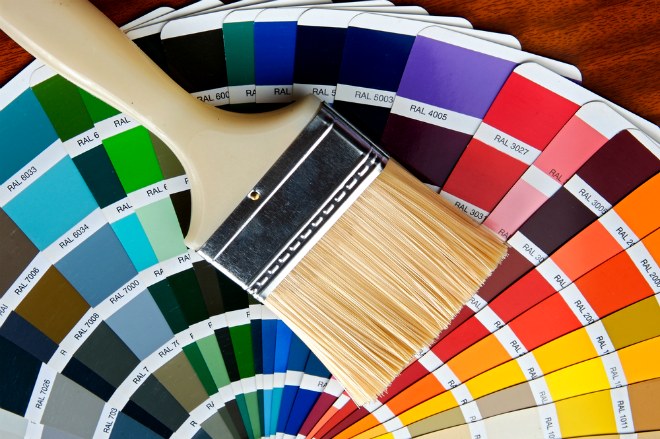
Tinting of water-based paint is carried out both independently and with the help of a special machine, in which all specified proportions are observed. Stores offer this service free of charge, however, the shade created by the machine does not always live up to expectations.
To mix the color, pre-prepare small clean containers, it is better if they are made of glass or plastic. You will also need a construction mixer or a wooden spatula, rags, a substrate made of paper, plastic wrap or thin cardboard.
When tinting paint at home, follow the following sequence of actions:
During the experiment, try the obtained options on the surface and evaluate the result after about 5-6 hours. If everything suits you, you can start tinting the desired volume, focusing on the proportions in your notes.
Pour the right amount of water-based paint into the prepared container. Shake the bottle with the coloring composition well so that it acquires a uniform consistency. Enter the desired shade in predetermined proportions, mix well.
In order for the quality of the composition to be optimal, the dye should be no more than 3% of the total mass of the water-based emulsion, that is, the consumption of color per 10 liters of paint is 300 g.
To achieve the desired effect, test the resulting composition on the working surface, let it dry, examine it in different lighting conditions.
Before painting the surface with tinted paint, mix the mixture thoroughly again, since coloring pigments tend to settle to the bottom.
Fill the remaining color for water-based paint in a bottle with water, so it can retain its original characteristics for 3 years.
Carrying out painting work during repairs is not only responsible, but also difficult, because in the end everyone wants to get a unique result. To achieve this goal, it is necessary to choose the paint of the desired shade, and its tone should look favorably in the renovated room. It is not always possible to find the right color on store shelves, for this reason you have to tint the paint yourself. How to do it according to all the rules - about this in our article.
Today, you can easily find any dye on an organic and inorganic basis. The first option allows you to get saturated shades, which, unfortunately, lose their properties over time, fade and fade. Inorganic additives are more resistant to atmospheric and other influences, however, their palette is much narrower compared to natural materials. The product range is presented on the market with universal colorants and formulations designed for certain types of paints.
To obtain the desired color, the amount of color varies depending on the type of paintwork material. So, for oil paints, the maximum amount of colorant should not exceed 1.5–2% of the total volume, in water-soluble paintwork materials its amount can reach 20%, and a maximum of 5% is added to all others.
It is necessary to distinguish between the concept of tinting and glazing. In the first case, color is added to white paint to achieve the desired shade. The second term refers to the mixing of two different colors to obtain a third (yellow + red = orange).
Manufacturers offer colorants in powder, liquid and paste form. For independent use, liquid dyes produced in small volumes in syringes or bottles are better suited. They are simple and easy to use. With their help, it is easy to change the shade of the paint, adding more dye for a rich color. In addition, it is allowed to use liquid color for painting in undiluted form as a coloring material.
But for mixing on professional equipment, powders and pastes are better suited. Dry dyes are inexpensive, but it is difficult to achieve the desired shade with their help, and their choice of colors is small. As a rule, before adding the powder, it is diluted in a liquid that corresponds to the composition of the paints (linseed oil, water). Pasty materials require exact proportions from the master, otherwise the color may turn out to be much lighter or darker than the desired result.
To perform tinting does not require any special skills. Do not be afraid to get to work, even if there was no such practice before. Even a beginner can handle tinting. The only rule that we must adhere to if we mix a colorant with paint with our own hands is to make as much material as it takes to paint the entire room, since, alas, it will not work to achieve a similar shade when re-mixing, no matter how hard we try.
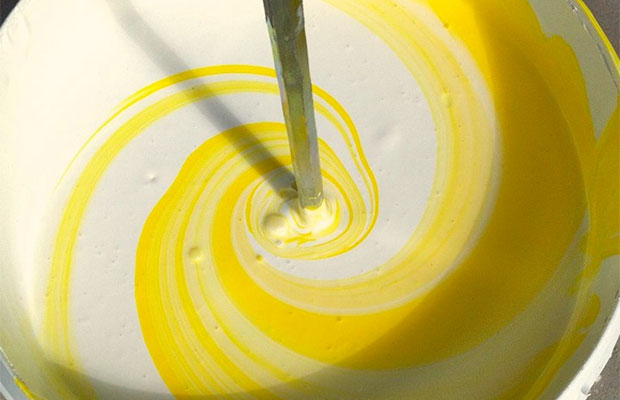
The technology for obtaining the desired shade is quite simple. First, we prepare a container where we pour the required amount of white paint. We recommend buying paint from one manufacturer, since each of them has its own composition, and the shade of white may differ. We measure the required amount of color according to the instructions to obtain the desired result. It is preferable to knead the paint before starting work, if we plan to get a bright color, since over time the colorant settles and the color becomes less bright. Constant stirring of the prepared mixture will help to cope with this.
For tinting, use snow-white paint to achieve the desired result. Using plain white paint can be very frustrating because it has a yellowish tint that can distort the final result. For mixing, we use a drill with a mixer specially designed for paints. It is easy to distinguish it from others - all its elements have a rounded shape. We introduce the colorant gradually, for a start we add only 2-3 drops and look at the result. If you need a more saturated color, add one drop of color, continuously stirring the paint at low speed. We continue to do until the resulting color completely satisfies us.
Machine tinting allows you to get the desired shade based on the base white paint. Compared to the manual mixing method, computer selection allows you to more accurately and in a matter of minutes get the desired shade. For this, special tables are used, which reflect all the resulting colors of the color scheme. Tables exist both on paper and in electronic form. Thanks to them, it will not be difficult to choose the necessary recipe that will help you get the desired color. In addition, machine mixing makes it possible to repeatedly create the required volume of the desired colors, without fear of getting a different tone.
Unfortunately, it is impossible to prepare the paint of the desired shade by machine at the place where the painting work will be carried out. Also, computer tinting in terms of the number of shades is much inferior to manual mixing, with which you can achieve truly unique tones. On the other hand, the machine method of preparation allows you to reduce the mixing time to a minimum - the process takes about 5 minutes. This is extremely important, especially if you need to prepare a large amount of paint of the selected volume. It is impossible to do this task manually.
The composition of the tinting system includes:
In some cases, when the color scheme for paint is supplied semi-automatically or manually, recipes are used instead of software, where the proportions of component displacement are indicated. In a fully automatic mode, the machine independently dispenses the required amount of paste or dry matter according to the selected formula and, adding it to the base, mixes it thoroughly until a homogeneous mass is obtained.
The most commonly chosen paint for walls and ceilings in the house is a water-based emulsion. She is easy to apply. By adding pigment to it, you can achieve a variety of shades that cannot be found in ready-made. However, not everyone knows that water-based paint is available in several types. Depending on the type of polymer used in the preparation of the base composition, acrylic, mineral, silicate and silicone compositions are isolated. The color scheme for water-based paint is selected on a water basis, since it is compatible with all the compositions presented.
Acrylic paint is most often found on store shelves. It is presented in the widest range and is very popular due to the ratio of price and quality. Paint is produced from acrylic resins and a number of additives that give the paint certain properties. So, for example, latex allows the use of acrylic paint in wet areas, as it repels water. Kohler for acrylic paint universal is used, which allows the mixture to be used for painting any surface. The paint dries quickly enough, which reduces repair work.
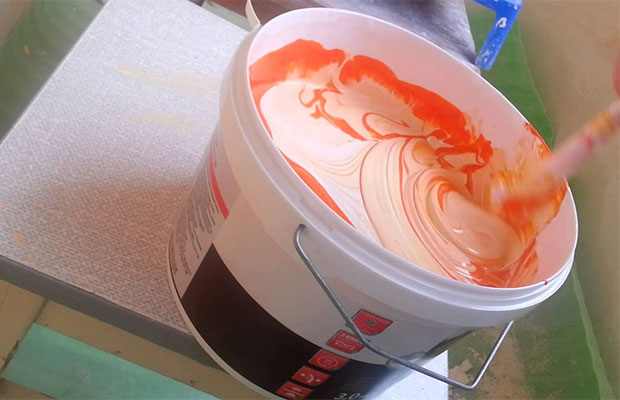
A more expensive option for a water-based emulsion is silicone-based paint. It is suitable for painting surfaces in wet rooms, while not creating a vapor-tight film, but allowing the surface to breathe. Water-based paint with the addition gives the surface an important property - it absorbs excess moisture and returns it back when the air is too dry. After tinting, such paint is excellent for outdoor use, as it endures all weather phenomena, but, unfortunately, it is not recommended to use it in rooms with constantly high humidity.
If the plans are to paint surfaces such as concrete, brick and plaster, then at the very time to use a mineral water-based emulsion. It contains slaked lime or cement, which allows the paint to endure moisture, chemically aggressive environments and ultraviolet. Color for water-based paint based on mineral additives use the most common. And you can prepare the desired shade both by machine and by hand.
Before proceeding to obtain the desired shade, it is mandatory to carry out test mixing. For these purposes, we take several identical containers, the volume of which is 100 ml - it will be easier to calculate the required amount of paint and dye. We start with 1-2 drops, especially if we plan to prepare a mixture of light colors. If the result obtained did not suit us with something, we begin to add the dye 1 drop at a time, while constantly stirring the composition. When the desired result is achieved, note the amount of color added.
Do not rush when preparing the desired tone, as the result may disappoint you. It is necessary to gradually add the colorant and mix thoroughly. If the color turned out to be more saturated than expected, you can add a little base.
When mixing several shades, be sure to use special artistic tinting tables from the manufacturer, which will help achieve the desired result. After obtaining the desired shade, we paint a small area of \u200b\u200bthe surface with it and wait for complete drying. This will allow us to see what the final result will look like indoors. Be sure to compare how the color looks in natural and artificial light, because the differences can be enormous. And do not forget that cold light gives the paint a bluish tint, and warm light gives yellowness.
To tint the entire volume of prepared paint, we observe the correct proportions of the base and dye. There is one rule: when preparing large volumes of mixtures, 20% must be subtracted from the calculated volume of color. We do this in order to achieve the desired color when completely dry, since the painted surface of large volumes looks much brighter than a small painted fragment. When painting small areas (up to 1 m 2), the proportions can be left unchanged.
It is far from always possible to find the right shade of paint on the shelves of hardware stores. As a rule, standard colors are presented on the market, and to obtain the original shade, paint tinting will be required. Consider the varieties of colors, features of the manual and computer mixing methods, and also give step by step instructions paint coloring.
Tinting is the process of mixing or diluting paints and pigments to achieve desired shades. To get the optimal tone, you can order tinting from a specialized company or mix the colorant and the finished paint yourself.

Tinting is indispensable in the following situations:

Tinting allows you to replace complex painting work with a small cosmetic repair
You can quickly and accurately get the perfect even tone of paint with the help of tinting systems. To do this, use the main base paint and coloring compositions - colors. Colors have a contrasting or saturated color. Coloring pigments of colorants can be of organic or inorganic origin. Organic-based pigments are more often used to achieve brighter tones, but they have some disadvantages:
Inorganic pigments are available in a limited range of shades, but they are resistant to weathering and fading.
Colorants are produced in the form of pastes, paints and dry formulations.
Color pastes contain dispersant resins or are produced without a binder. There are universal pastes suitable for various types paints, and highly specialized - for certain categories LKM.
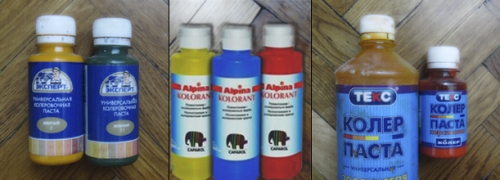
The main advantages of color pastes include:
The disadvantage of a viscous color scheme is the lack of standard color and saturation characteristics of the paste. The end result can be a "surprise" due to the uneven intensity of the color paste.
Coloring paints have the same components as the coatings for which they are intended - water-based, acrylic, oil, etc. The combination of white paint and such pigments allows you to get any shade. To obtain a very bright effect, you can use the colorant undiluted.

Dry pigments have a relatively low cost. The disadvantages of bulk mixtures include:
There are a number of tinting systems of European, American and Russian production on the construction market. Among foreign companies, the colors Tikkurila, NCS, Huls, etc. are popular. stability and good quality demonstrate inexpensive domestic colorants Palitra (Izhevsk enterprise " New house”), Olki-Unicoler (St. Petersburg), Halo and Dali.
To tint Tikkurila paint, the Tikkurila Symphony mixing system is used, which is based on paint and varnish chemistry. The manufacturer guarantees an accurate result and "hit in color". The system is designed for tinting general construction and household interior paints. The Tikkurila Symphony color scheme includes a large number of colors - 2256 (of which 10 are shades of white).
![]()
Separately, a line of colors for facade work was developed - "Tikkurila Facade". The system includes 232 colors for painting wood and stone surfaces.
To perform the tinting of antiseptics and varnishes, it is necessary to use a separate group of Tikkurila colors
The Natural Color System (NCS) is the Swedish and Norwegian standard for naming color shades. This is the generally accepted and most common tinting system in the world. The basis of the NCS system is six basic colors: black - S, white - W, yellow - Y, red - R, green - G and blue - B. The remaining colors are endowed with a visual resemblance to elementary tones and have their own encodings. Letter designations indicate the presence of one or another base color, and digital designations indicate its amount as a percentage.

The Tex company produces colors based on imported pigments using high-quality German equipment. Colors are available in the form of paints and pastes.
Tex color pastes are universal, applicable for tinting putties, water-soluble paints, alkyd materials and whitewash compositions. Color paste - frost-resistant.
Important! Permissible content of paste "Tex" - no more than 10% of the total volume of paint. When working with the material, it must be taken into account that the result may vary depending on the quality and type of paint used.
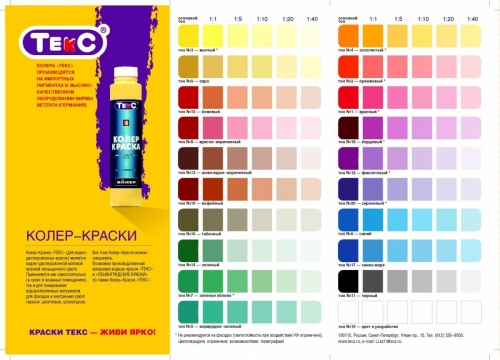
Kohler paint "Tex" is designed for water-dispersion paints, resistant to external factors. It is applied to internal and external works.
The Aqua-Color company (St. Petersburg) produces universal colors in the form of paste and paints. Pigments are used for tinting alkyd, oil, water-based paints, grouts, as well as cement and lime mortars. Colors do not change the properties of paint. Aqua-Color products are affordable and have a wide range of applications: renovation of apartments, office space, processing of building facades, etc.
The firm "Olki" produces universal frost-resistant tinting pastes - "Unicoler", intended for tinting:
Important! Unicolor paste cannot be used as a paint, as it does not contain film-forming substances
The Rogneda group of companies (Moscow) produces Dali tinting paints. The main purpose of the color:

Tinting paints "Dali" have a number of advantages:
You can mix the paint manually or with the help of special equipment. Each of the methods has its own advantages and disadvantages.
For tinting by hand you need to purchase a base paint and a coloranat kit. Immediately before staining, the pigment is added to the paint in proportions according to the instructions and mixed. This method has the following advantages:
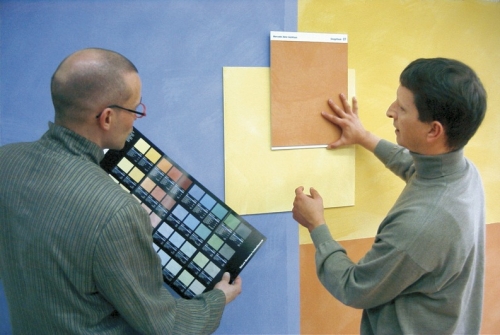
The main disadvantage of manual coloring is that the resulting shade is difficult to reproduce again.
Automated mixing LMB is under control computer program. It is enough to choose the desired color, and the machine itself will determine the proportions to obtain the desired shade and give out the finished mixture. The advantages of the computer method are obvious:
Tinting paint by machine method cannot be done with reference to the object. In addition, in this way it will not be possible to create a complex tone or shade.
When choosing a color scheme, two main criteria must be considered:
Some pigments are universal - they are suitable for tinting different colors and are used to create the desired shade in the interior of a room or building facade.
When mixing colors with different paintwork materials, the following rules are followed:
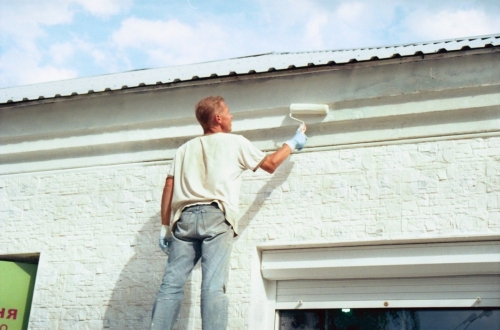
The whole process of tinting paint can be divided into the following steps:

Example. To obtain the optimal shade per 100 ml, it took 5 drops of color, it is logical that 50 drops would have to be used to color 1000 ml of paint. However, it is not. To achieve the desired result, if 40 drops of dye are added to 1000 ml

It is quite possible to do the tinting of the paint yourself. The main condition is to act slowly, add the pigment gradually and evenly mix the paint.
If during repairs in the house there is a desire to paint the walls with water-based paint, then the desired color can only be achieved by using tinting. But getting the right tone at home for many is a very difficult task. Ready-made solutions do not always meet the needs of the owners of the apartment being renovated, and in order to get the best color solution, often you have to make tinting with your own hands.
 When a complex color is needed in the interior of the room, which is not on sale, then there is a need to obtain this shade on our own. To get a complex color, it's better in person choose a few colors to get the desired shade.
When a complex color is needed in the interior of the room, which is not on sale, then there is a need to obtain this shade on our own. To get a complex color, it's better in person choose a few colors to get the desired shade.
When it is planned to paint a room in two or more colors that harmonize with each other, then, of course, it is necessary to select water-based colors. Sometimes the selection of water-based colors is necessary for a harmonious combination of the color of the walls and interior elements of the room.
From the foregoing, one simple rule can be deduced: to obtain complex colors, it is better to mix water-based colors with your own hands in the room that is supposed to be painted. In addition, choosing paint in this way, you can get the desired shade, which cannot be achieved when buying store counterparts.
Difference in colors happens for one simple reason: the tinting machine simply prepares the necessary shade of color, but it is able to change the shade to a tone lighter or darker, depending on the illumination of the room, its area. Therefore, acquiring finished products in the store, the consumer risks getting a darker or lighter room than originally planned.
In the photo you can clearly see what colors of colors for paint are.
To select the desired shade of color, you must follow these simple rules:

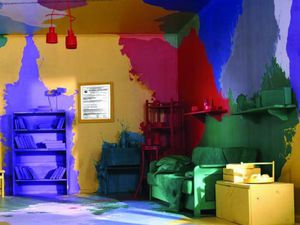 The quality of the finished coating will not be significantly affected manufacturer and color composition. The price of domestic paints and colors is much lower than imported analogues. The whole difference between colors lies in the shades of the main color from different manufacturers.
The quality of the finished coating will not be significantly affected manufacturer and color composition. The price of domestic paints and colors is much lower than imported analogues. The whole difference between colors lies in the shades of the main color from different manufacturers.
For those who do not have sufficient experience in the use of such a material, it is better to choose a tube with a narrow neck as a training option. The color scheme must have the desired color, and the base must be selected taking into account the type of surface to be painted.
Today, materials are produced specifically for each surface, so there is no need to buy a ceiling base for walls. As a basis, it is better to purchase imported paint, because it should have a snow-white appearance. The presence of pigments can adversely affect the desired shade of color. And the yellowish tint that some raw materials have cannot be removed by anything.
By purchasing low-quality products with a yellowish tinge, there is a serious risk of getting an orange tint instead of the desired red, green can become light green, and mixing such a paint with a purple tint can turn it into a dirty gray tone. In order not to spoil your mood at the very beginning of painting the apartment, it is better not to skimp on the purchase of a high-quality snow-white base. In the photo you can see a universal color for water emulsion.
At the heart of each type of paint and varnish materials is a certain type of polymer, which serves as the basis for each type of paint. It is better for a beginner in this business to study in advance all the characteristics of paint types and their scope in order to choose the right option for repair.
All paint of this type can be divided into four types:
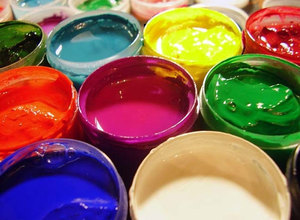
The process of coloring paint to obtain the desired color does not look complicated if follow a certain sequence ongoing work. In practice, it looks like this:
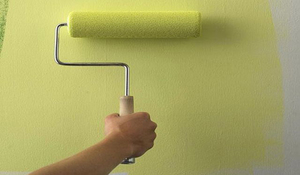 All preparatory work can be in vain if the material is not properly applied to the surface. Water based paint can be used for concrete, brick, plaster, drywall and other similar materials. If you do everything simple rules the paint will last for a long time.
All preparatory work can be in vain if the material is not properly applied to the surface. Water based paint can be used for concrete, brick, plaster, drywall and other similar materials. If you do everything simple rules the paint will last for a long time.
Before painting, remove all furniture from the room or cover it with a film. This is due to the rather liquid consistency of the paint. Before painting the surface, it is necessary to carry out thorough preparation: remove exfoliated coatings, plaster if necessary, wash off the old whitewash.
Smooth walls, on which there is an old water-based paint, should be carefully dust off and dry. In order not to stand out old cracks after painting, they should be repaired with putty. All streaks and stains on the old surface must be painted over with oil paint that matches the color of the color scheme.
All metal parts that can be found on the painted surface must also be covered with oil paint. It is better to take oil paint a tone lighter than the main color for painting the surface.
Before painting, the surface after treatment should be coated with a primer. This is necessary for better adhesion of the paint to the painted surface, as well as for protection against moisture, which will extend the service life. After priming, it lays down in a more even layer, which helps to reduce material consumption.
acrylic primer goes perfectly with this type of paint. The finished paint can be applied to the surface either with a paint roller or brush, or with an airbrush. When using an airbrush, do not forget about purchasing a respirator.
When applying with a roller, you should purchase a special tray that will help remove all excess. Apply it with vertical movements. Start painting the room from the furthest corner from the entrance. It will be necessary to apply this material to the surface in several layers. Re-staining should not be carried out earlier than four hours after applying the first layer. The application of paint with a roller on the surface of the wall can be seen in the photo.